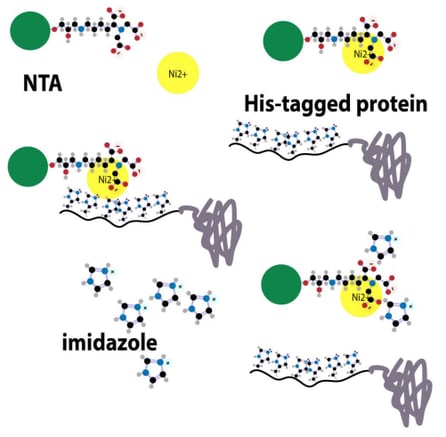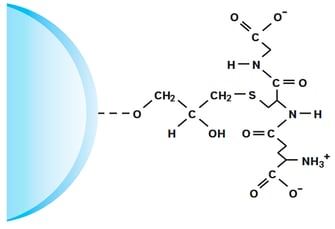Finding the right affinity tag can be a challenging task for many. The process requires not only an understanding of your protein but also the downstream process of your purification. You need to find a tag that has selectivity and specificity to your desired protein. Lastly, you need a tag with minimal effect on your protein’s structure and allow for your protein to bind effectively. To help you find the right tag, we will talk about some commonly used affinity tags. This will hopefully give you a better idea of the best affinity tag for your protein and make the decision a little easier.
| Characteristic | HIS (Ni-IMAC) | GST (Glutathione) | Biotin (Streptavidin) |
| Affect solubility? | No enhancement | Possible enhancement | No enhancement |
| Tag removal | Not needed | Site-specific protease | Not needed |
| Structure | Minimal effect | May affect function | Minimal effect |
| Metal-containing proteins | Not compatible | Compatible | Compatible |
| Elution Conditions | Imidazole is mild but may be incompatible with downstream |
Glutathione is mild | Very difficult to elute (free biotin or high salt, low pH buffer) |
| PhyTip capacity | High | Low | Low |
| Affinity | Med | Low | High |
HIS (Ni-Imac) Tag
Proteins that have an affinity for metal ions can be separated using metal chelate affinity chromatography. The metals are immobilized onto a chromatographic medium by chelation. Ni-IMAC is a great purification method due to its selectivity and capacity to His-tagged proteins. However, there is a chance of background binding due to residual histidine containing proteins in mammalian cells. It is recommended to remediate this issue by equilibrating, washing, and eluting in varying concentrations of imidazole. This will help prevent non-specific binding and facilitate the purification of your His-tag protein.
 Figure 1. Inner workings of Protein Purification: Binding of Ni, Cu, Co, Zn-iminodiacetic acid to Histidine Tags. Credit: SFA University
Figure 1. Inner workings of Protein Purification: Binding of Ni, Cu, Co, Zn-iminodiacetic acid to Histidine Tags. Credit: SFA University
Proteins that have an affinity for metal ions can be separated using metal chelate affinity chromatography. The metals are immobilized onto a chromatographic medium by chelation. Ni-IMAC is a great purification method due to its selectivity and capacity to His-tagged proteins. However, there is a chance of background binding due to residual histidine containing proteins in mammalian cells. It is recommended to remediate this issue by equilibrating, washing, and eluting in varying concentrations of imidazole. This will help prevent non-specific binding and facilitate the purification of your His-tag protein.
GST(Glutathione-S-Transferase) Tag
Glutathione-S-Transferase (GST) is a large protein that has its DNA sequence commonly integrated into expression vectors for the production of recombinant proteins. The protein of interest is expressed after translation forming a GST-tagged fusion protein attached by the N or C terminus of the recombinant protein. GST acts as a chaperone for the attached protein and promotes greater expression and solubility of recombinant proteins. This is due in part to GST’s ability to fold quickly into a soluble protein upon translation.
 Figure 2. Terminal structure of Glutathione Sepharose. Credit: Cytiva
Figure 2. Terminal structure of Glutathione Sepharose. Credit: Cytiva
GST-tagged proteins strongly bind to immobilized glutathione and are an effective method for purification. However, the addition of the GST tag alters the native state of the protein of interest. Lastly, the binding kinetics between glutathione and GST are relatively slow.
GST tag is best used as a labeling protein for purifying proteins with either unknown or known biochemical properties. GST can be used to increase expression and solubility of proteins in bacteria, yeast, and mammalian cells. GST is best suited for a pull-down assay to study uncharacterized proteins and protein-protein interactions of the target recombinant protein. Due to its size and interference with tagged recombinant protein function, GST is not well suited for some downstream applications.
Biotin (Streptavidin)
Biotinylation is the process of attaching biotin to your target protein. The biotin affinity tag is relatively small and has a very strong affinity to avidin and streptavidin. Due to this strong noncovalent interaction, it is highly selective and reduces the potential for background binding. The interaction is very rapid, and once formed is resistant to, temperature, extreme pH denaturants, detergents, and organic solvents. An example of the advantages of strong covalent binding is performing an acid dissociation without breaking the biotin bond.
However, due to the high binding affinity of biotin to avidin, eluting your biotinylated protein from an immobilized streptavidin can be difficult. The elution process can be very stringent and has the possibility of denaturing your protein. It is recommended to use free biotin to elute your target to avoid denaturing your protein.
Biotin is best suited for the detection of proteins due to its labeling ability and strong binding. Due to its strong binding to streptavidin and avidin, biotin is used in many cases when trying to permanently immobilize a protein to a column. Biotin is often used in early-stage drug discovery using an immunoprecipitation pull-down assay to study drug-to-drug interaction.
FLAG Tag
The Flag®-tag is a short, hydrophilic protein tag commonly used in conjunction with antibodies. The Flag-tag can be added either to the N-terminus or the C-terminus of a protein. Due to its hydrophilicity, the Flag-tag is commonly found on the surface of a fusion protein. In addition, the high hydrophilicity and small size of the Flag-tag have little effect on protein function, expression, maturation, and antigenicity.
The Flag-tag can be used for the purification of any recombinant protein fused to the Flag-tag, using agarose resins or magnetic beads that are coupled to an anti-Flag antibody. However, high protein yields cannot be achieved with the Flag®-tag due to low capacity. Although low yield is common using Flag-tag, the purity of your sample is higher due to the binding specificity of the tag.
The Flag-tag is best suited for fused membrane protein purification which makes it more available as an epitope for binding to antibodies. The Flag-tag is used in conjunction with antibodies in protein pull-downs to study protein–protein interactions. Additional applications to use the Flag-tag are as an affinity tag in Western blots and Immunoprecipitation assays.
Fc Tag
Fc (Fragment, crystallizable) tags are affinity tags that are derived from the Fc region of immunoglobulin G (IgG) antibodies which are naturally secreted proteins that have a high expression yield and stability in vivo and in vitro. They are often fused to the C-terminus or N-terminus of a protein of interest. Fc tags are specifically engineered to bind selectively to protein A, G, or L resins. Fc region is composed of two identical protein fragments, derived from the second and third constant domains of the antibody's two heavy chains.1
Fc tags are compatible with various protein expression systems, including bacterial, yeast, insect, mammalian, and plant cells. Fc Tags can increase the solubility and stability of the tagged protein. By promoting proper folding and reducing aggregation, Fc Tags enhance the yield and reliability of the protein purification process. This characteristic is particularly beneficial for proteins that are otherwise difficult to express and purify. The Fc tag is naturally soluble and usually does not interfere with fusion protein folding.2 This can help maintain the solubility of problematic target proteins.
Fc tags can be expensive to produce and purify since they require mammalian cell expression systems and affinity resins.
HA Tag
HA tag is a short amino acid sequence obtained from the hemagglutinin protein of the influenza virus A and is fused to the N- or C-terminus of a target protein of interest. They are hydrophilic, flexible, small in size (9 amino acid sequence YPYDVPDYA), and minimally disrupt the structure and function of the tagged protein. HA tags are highly specific, efficient, and compatible with a wide range of protein expression systems and purification methods. In addition to its utility as an affinity purification tag, the HA tag is commonly used for detecting recombinant proteins through western blot, ELISA, and immunoprecipitation.
HA tags have high specificity and low background due to their unique amino acid sequence so they will not bind to other proteins in the host cells. HA tags are used with other tags in tandem, such as FLAG tag, Myc tag, and His tag, and offer enhanced specificity, yield, and flexibility.
The HA-tag is not suitable for detection or purification of proteins from apoptotic cells since it is cleaved by Caspase-3 and/or Caspase-7 after its sequence DVPD, causing it to lose its immunoreactivity.3
Wrap up
It is important to remember that each tag has its advantages and disadvantages. Finding the best affinity tag is based on your workflow’s unique needs and is one of the most important decisions you can make when engineering proteins. Now that we have talked about some commonly used affinity tags, hopefully, it will help you to make a more informed decision on your tag selection.
Reference
1. Fragment crystallizable region
2. Fusion tags to enhance heterologous protein expression. Appl Microbiol Biotechnol 104, 2411–2425 (2020)
3. The HA tag is cleaved and loses immunoreactivity during apoptosis. Nat Methods 4, 107–108 (2007)
4. GLUTATHIONE TRANSFERASES. Annu. Rev. Pharmacol. Toxicol. 45, 51–88 (2004)
5. A Short Polypeptide Marker Sequence Useful for Recombinant Protein Identification and Purification. Bio/Technology. 6. (1988)
6. Tagging for Protein Expression Methods in Enzymology 463, Pages 239-258, (2009)


